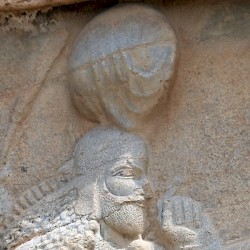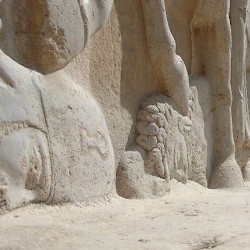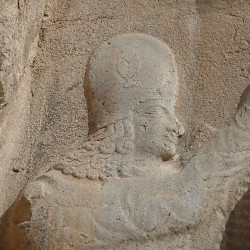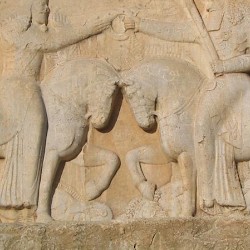Naqš-e Rustam, Investiture Relief of Ardašir I
Q5942066Naqš-e Rustam: archaeological site in Fars (Iran), best known for its Achaemenid tombs and rock reliefs made in the Sasanian age.
Relief of Ardašir I
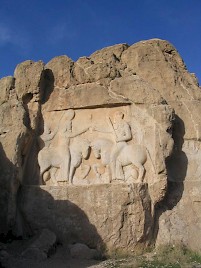
The Investiture Relief of the Sasanian king Ardašir I (r. 224-241) is the oldest Sasanian monument at Naqš-e Rustam. Ardašir was born as the son of a Zoroastrian high priest from Istakhr, immediately north of Persepolis, where the ancient cults of the Achaemenid Empire were continued. When Ardašir revolted against his Parthian overlord, he developed a new royal ideology. He more or less admitted that he had been a rebel and had betrayed his master Artabanus IV, but, he claimed, he had done so because the supreme god Ahuramazda (or Hormuzd, as he was often called in this age) had wanted him to do so. The relief of Ardašir fits into this propaganda and the site is logical: close to the ancient capital of the Achaemenids.
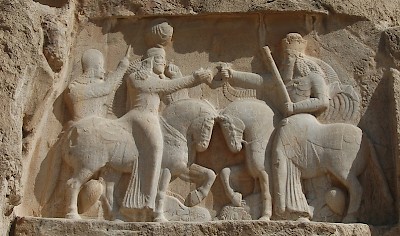
To the right, we can see Ahuramazda, who is handing over a ring to Ardašir, on the left. Both figures can be identified by their crowns. This ring, which is usually called cydaris, is the symbol of power. Both men are seated on horses and are crushing defeated enemies: king Artabanus under Ardašir's horse and the devil Ahriman under Ahuramazda's one. To the left is an attendant with a fly-whisk; this man is also depicted on other reliefs of Ardašir (e.g., at nearby Naqš-e Rajab).
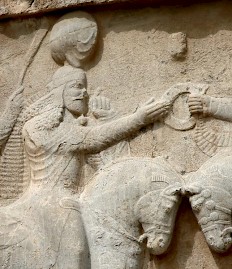
Ardašir is shown accepting the ring of power with his right hand, while saluting the god with his left fist and pointed index finger. This gesture can be seen on many Sasanian rock reliefs and is still made toda ;by the nomads of the Zagros Mountains. His crown has a rather unusual globe, which is called korymbos.
The Investiture Relief of Ardašir I is extremely important, because it marks the beginning of the Sasanian royal art. Other investiture reliefs by Ardašir are found at nearby Naqš-e Rajab and, at some distance, near Firuzabad. On these reliefs, the king is shown standing. The equestrian type, made for the first time in Naqš-e Rustam, was to become the most popular type of investiture relief. Later kings ordered identical reliefs to be made, e.g., Shapur I at Naqš-e Rajab and Bahram I at Bishapur V.
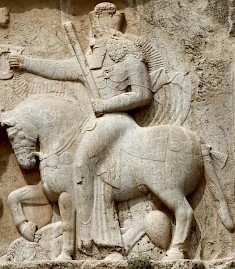
From the holy book of Zoroastrianism, the Avesta, we know that the bundle of sacred twigs in Ahuramazda's left hand is called the barsom. When this relief was cut, this symbol of religious power already had a very long history; barsoms are already depicted on Achaemenid reliefs (e.g., Dascylium). Behind Ahuramazda's head is a ribbon, usually called diadem, a symbol of power.
The Dutch traveler Cornelis de Bruyn has recorded that in the early eighteenth century, the local people believed that the people on this relief represented Darius III Codomannus, who handed over his power to Alexander the Great.
Literature
Louis Vanden Berghe, Reliefs rupestres de l' Iran ancien (1983 Brussels), #53.
